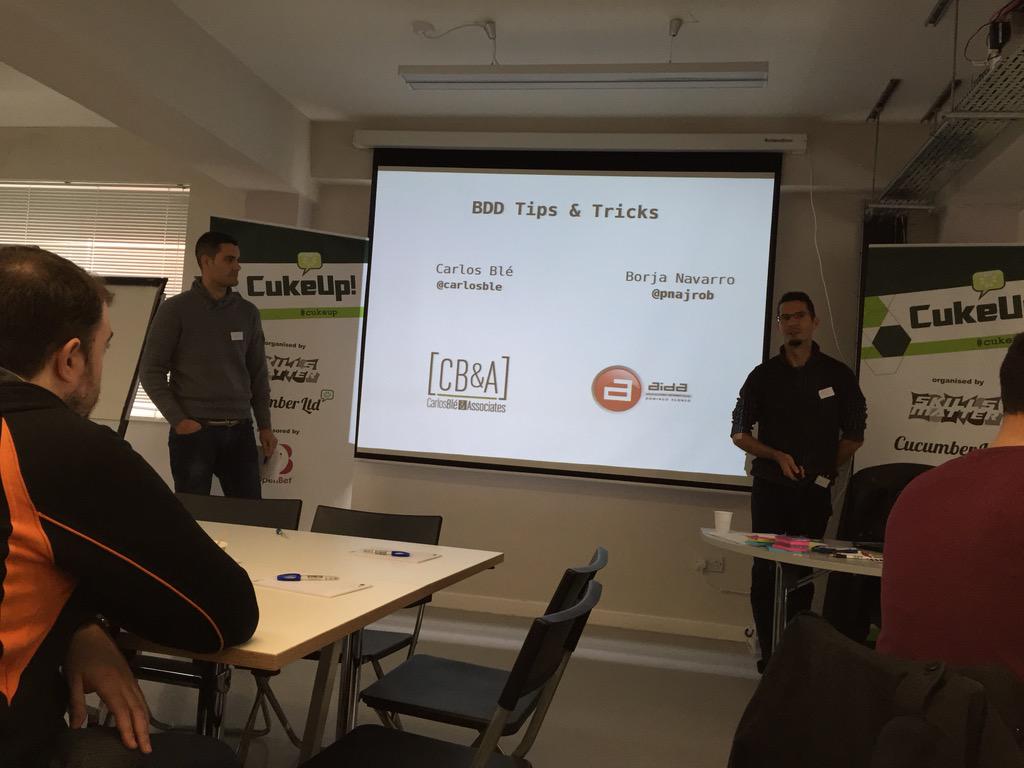I had the pleasure of speaking at CukeUp! this year (2015), the fifth edition of Cucumber’s conference which is more about BDD than Cucumber itself, although there are always updates on the state of the tool (this year Matt released version 2.0 during his talk!)
It’s been a great conference, I’ve learned a bunch of things, met friends and new people. My colleague Borja Navarro accepted the challenge of co-presenting with me and that made our session fun, a least for me, a had a lot of fun. We engaged the attendees with a couple of examples together with questions and answers on how to write user stories with acceptance criteria and scenarios. The attendees were very helpful and active. This is the recorded session, although the sound is quite bad.
Thank you Borja, you rock mate!
These are my conference picks:
- A mature XP team don’t need to have people exclusively for testing and QA purposes. If every developer has testing skills and every pair is responsible for quality then people just play the two roles but there is no such distinction between testers and developers. There will be people with stronger development skills and people with stronger testing skills, experts on each area. Well, this is my understanding from Rachel’s and Aimy’s keynote.
- They don’t have a staging environment, they release directly into production, performing some smoke testing live with some “testing” user accounts. I find this technique specially interesting when the new features can be deployed just on a few servers so that only certain users get to exercise the new code whilst the others keep using the previous version for a while. Exploratory testing and other tests are performed on the development environment. The maturity level of the team has to be very high, sounds like a nice goal to reach at my current project.
- I participated in Paul Rayner’s useful workshop, specially nice because I got the chance to share table with Steve Tooke and Gáspár Nagy, experts on the subject. My pick is that any technique that could help with discovery during the analysis stage is welcome. One of the suggested techniques was Event Storming, which I am going to trying as soon as I can. Since we are using DDD in our project, Event storming sounds like a great technique to combine analysis and modeling.
- From Seb’s talk there are many ideas to take away, it’s worth reading the slides. I already listened to his talk in a previous event in London and I want to read the recommended books. Take a look at this map on how to split user stories.
- Konstantin Kudryashov, creator of Behat, gave an interesting talk on how to explore and exercise the domain model from Gherkin scenarios, the slides are here. My understanding was that he uses domain objects within the step definitions as if these steps were unit tests. The approach is a bit different from the one we are using where the step definitions invoke actions on application services rather than objects from the inner hexagon. Although we use application services we usually stub out or spy on repositories aiming for fast tests. Another technique he employs is to mark a few scenarios as critical making them run end-to-end through the UI so as to make sure all pieces integrate with each other. It’s good to know the techniques that are working for other people and see how they are different to the ones we currently use.
- The keynote by Dan North was full of insight, I highly recommend watching it. I didn’t watch it live as I prefer to chat with people whilst talks are being recorded – at that time I took the chance and enjoyed listening to Chris Matts in the bar. To me, the most interesting tip is the experiment Dan is conveying where every team member’s board has to have Kaizen tasks, Discovery tasks and Feature tasks. Brilliant, isn’t it?
- The workshop by Chris Matts and Richard Warner was full of insightful ideas. I liked the exercise on “Left Shifting” company’s culture. On the other hand they explained their discovery process when it comes to feature analysis. The three keys to discover new features are “Customer needs and wants”, “Target group” and “Outcome”. The workshop was recorded, it’s worth watching that part of the session which was more of a talk than a workshop. My understanding is that they are not using user story mapping at all. It was really nice to share table with Nat Pryce during the workshop, he was very active and fun, I am glad I got to know him in person finally.
- Matt Wynne’s workshop was one of my favorite ones. I really like the password strength exercise to illustrate the difference between acceptance criteria (rules) and examples. See these slides for more details. The other pick is “Example mapping” a technique where the colors end up making obvious what we know and don’t know about the context in order to write good user stories. I also realised that the examples used for exercises may work better when they are fun, when we add some humor to them. Writing user stories for a boring domain is not as engaging as writing them for some fun domain with curious situations.
At the end of the conference there was a panel with the experts, the creators of BDD. As a result Dan North came up with this initiative on explaining BDD by example. I want to contribute to those examples. By the way, Dan said he found John Ferguson’s book very good, I have to check it out.
CukeUp brought me more value than I expected, I am glad I was part of it. Thank you organisers, you made a great job!

